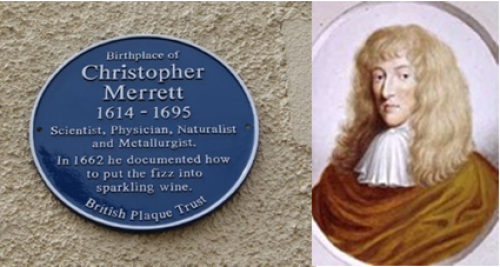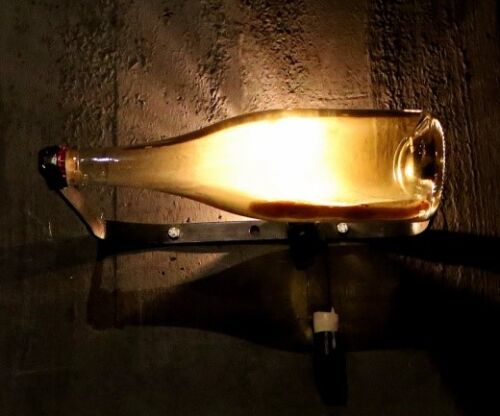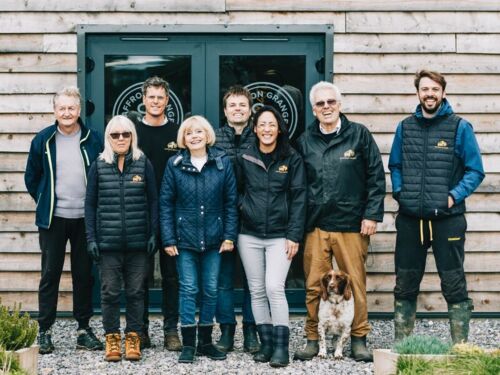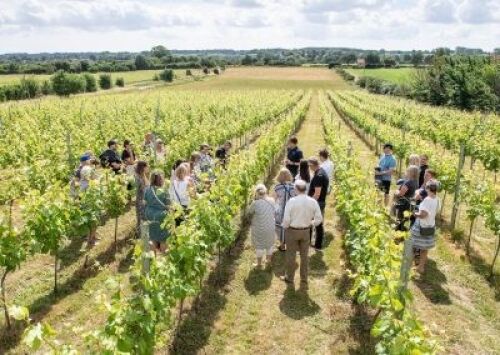By Nick Adams MW
Who First Invented (English) Sparkling Wine?
Quite probably an English scientist called Christopher Merrett - in 1662. In a paper presented to the newly formed Royal Society, Merrett described how English winemakers had been adding sugar to wines to give them a refreshing, sparkling quality - 30 years before a certain, very famous, monk in France's Champagne region. As Merrett wrote "Our wine coopers of recent times use vast quantities of sugar to wines to make them drink brisk and sparkling and to give them spirit".
The French monk in question was none other than Dom Pérignon, who was thought to have invented “Champagne”, or more accurately “sparkling wine”, in 1697. Today, such is the historical link to Pérignon and the power of (marketing) association, via the might of multinational producer Moët Hennessey that they have, in effect and legally, requisitioned the “trademark” and origin for this type of wine.
Have a look at the excellent Peter Graham Wines English selection in link below.
PETER GRAHAM WINES ENGLISH SPARKLERS
And today, Merrick would be pleased indeed to see just how far English sparkling wines have come. And this is not driven by some bovine patriotism but because top examples of these wines are now not only the best they have ever been – but are also, simply, world class.
Vineyards in England, not unsurprisingly, go back to Roman times – when they first brought over vine cuttings. It is doubtful whether the Romans migrated to the then Britain simply for the weather, and although we remain “marginal” in climatic terms to grow vines and grapes, we have paradoxically near perfect conditions for the production of high-quality sparkling wine. Before we look at that aspect, let us start with where the industry is today.

Vines are grown all over Southern and Central England and as far north as Yorkshire. There are also a dozen vineyards in Wales. In total there are now over 100 wineries which are open to the public to visit.
www.englishwineproducers.co.uk
Plantings have increased by over 150% in the last 15 years and today sparkling wine accounts for 75% of total production. The most popular varieties, by far, are Chardonnay, Pinot Noir and to a lesser degree (Pinot) Meunier – accounting for over 50% of all plantings. But why? Well, these happen to be the three noble grape varieties which are used in many wines made in the revered region of Champagne. And quite simply this is the target and aspiration for nearly all the quality English sparkling wine producers! And luckily, they have geography and climate on their side – most notably on the chalky soils of the South Downs in England.
Much attention is being focused on the importance of the chalky soils and microclimate of this area, which is a close as it gets in the world to the district of Champagne. The sweep of Downs across Sussex and Hampshire are the sunniest and warmest spots, on average, in England (it is worth noting that in Champagne the average mean temperature in July is only 18⁰C). They also receive lower than average rainfall. The very soil itself is like that in Champagne – with a high level of chalk. This not only allows for good drainage (essential in more marginal areas) but helps to reflect light and heat back up to the vines and grapes throughout the growing period – promoting ripeness. And the essential – maybe paradoxical – aspect here is that in the production of quality sparkling wine you need grapes which are ripe, but not too ripe – with high levels of acidity and restrained, not dominating, fruit flavours. And that just what grapes from the South Downs deliver.
So, bring the combination of soil, microclimate, Champagne grape varieties and you have all the makings of something serious, but you also need one final ingredient - investment and high quality (human) winemaking skills. And this is where English sparkling wine has really advanced in the last 10 or 15 years.
(Pictured:Pinot Noir vines on the Nyetimber Estate, South Downs)

Most English sparkling wines are made in the traditional, bottle fermented way like Champagne, although there are also high quality tank fermented examples (like Prosecco) - please see Flint Vineyards later on.
Left, English sparkling wine aging on its lees in the cellar

Nyetimber (Sussex & Hampshire)
Owner Eric Heerema and talented Canadian winemaker Cherie Spriggs (pictured with her viticulturist husband Brad Greatrix) have completely revitalised and elevated Nyetimber to the very top tier in the last 10 years or so. Now seen as an industry benchmark they produce a range of white and rosé - both non-vintage and vintage including top quality single vineyard selections. Their Special Cuvée delivers quintessential English style of crispness and bright fruit with delicate bottle and lees aged pastry notes.

Saffron Walden (Essex/Cambridge)
It’s not all about the South Downs though, on the Cambridge Essex border is the Saffron Walden sparkler which has also made the headlines. Owned by husband and wife team Paul and Ross Edwards (since 2008) - with Paul Harrison managing the vineyards, and Frech winemaker Matthieu Elzinga these are beautifully delicate and elegantly fruity bottle fermented sparkling wines. The Rosé is southern French pale and with bright red berry fruit; the white is classically taut with an apple and citrus kick.

Flint Vineyard (Norfolk)
Flint Vineyards was founded in Earsham, Norfolk in 2015 when winemaker Ben Witchell (a graduate in Oenology and Viticulture at Plumpton College) met with local farmer and businessman Adrian Hipwell and an immediate partnership was formed. The vineyard was already established but has grown since to 6ha with a mixture of both black and white grape plantings. From these both still and sparkling wines are made.
The Sparkling Rosé is made by the Charmat (tank fermented) method – the same process which makes Prosecco. It is a blend of 7 different varieties led by their estate grown Pinot Noir, with Rondo, Reichensteiner, Pinot Meunier, Cabernet Cortis, Solaris, and the aromatic Bacchus included in varying proportions. The majority (95%) was blended, then fermented, and aged in stainless steel, with a small proportion (5%) held in old oak casks for 4 months added to the original blend. Skin contact - mainly with the Pinot Noir element – has created a lovely rich rosé colour. The residual sugar is just under 9g/lt.

Paradoxically, global warming may be helping the English wine cause. Recent years such as 2018 and 2022 have just proved that with some of the finest ever wines being made.
And at this stage the image of Champagne, and the big houses and their top prestige cuvées, are some way off from being superseded. However, what these top English sparkling wines have achieved is to challenge mainstream Champagne head on in terms of style and quality. It’s maybe no surprise then that two top Champagne houses - Taittinger and Pommery - have invested directly into vineyards in England - a sure sign of things to come.
And not least as the daylight grows longer and stronger each day now, let’s look forward to spring and summer drinking and popping the cork on English sparkling wine.


